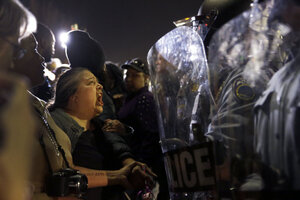Justice Department: Police overreach is not just a Ferguson problem.
The Department of Justice's final report on the police response to the unrest in Ferguson details a litany of missteps, including violation of protesters' First Amendment rights, and improper use of police dogs, armored vehicles, and snipers.

A protester yells at police outside the Ferguson, Mo., Police Department during a demonstration sparked by the fatal shooting of Michael Brown, Aug. 11, 2014. A final Justice Department report which will be released Thursday and obtained in advance by The Associated Press warns similar problems could happen in other places roiled by mistrust between law enforcement and the community.
Jeff Roberson/AP/File
A final version of the Justice Department report on the law enforcement response to the demonstrations in Ferguson, Mo., last summer was released Thursday, underscoring mistakes made by the city’s police department in attempting to quell the unrest.
In June, a draft of the report was released that painted a picture of a community tainted by a negative relationship with police and authoritative overreach by law enforcement that infringed on protesters' First Amendment rights, and military-style tactics that antagonized demonstrators.
The report gives a detailed chronology of the 17 days of protests and violence that followed the fatal shooting of unarmed 18-year-old Michael Brown by a white police officer.
In painstaking detail, the report delves into the police department's missteps immediately after the shooting including infamously keeping Brown’s body under white sheets for hours and withholding information from increasingly angry community members.
It then goes into various other mistakes made by law enforcement officials that raised tensions among police officers and the community, including the improper use of police dogs, armored vehicles, and snipers. Additional missteps like some officers removing their nameplates and various entanglements about authority and jurisdiction reduced the ability of law enforcement to effectively respond to incidents that required their attention.
The Ferguson shooting, along with other deaths of blacks at the hands of white police officers, sparked a national dialogue about police-community relations and the role of race in policing.
"In many ways, the demonstrations that followed the shooting death of Michael Brown were more than a moment of discord in one small community; they have become part of a national movement to reform our criminal justice system and represent a new civil rights movement," Ronald Davis, director of the Justice Department's Community Oriented Policing Services office, wrote in an introduction to the report.
The negative perception of law enforcement based on recent publicized incidents of police brutality has filtered through to the entire nation. A Gallup poll conducted in June found Americans had the lowest percentage of confidence in police since 1993, in the wake of the videotaped beating of motorist Rodney King.
The Justice Department’s report goes on to warn that while it is perceived that Ferguson is an individual case, similar protests and unrest could happen anywhere in the country "in which fostering positive police-community relationships and building trust are not a priority."
But what can be done to bridge the gap between police and the communities they serve?
Several reforms have been reformed since this most recent movement against police brutality, attempting to tackle various facets of law enforcement, reported Patrik Jonsson in The Christian Science Monitor.
Body cameras have gained popularity with the purpose of shielding both police officers and suspects from harm.
The Justice Department has changed the rules about how police departments obtain used military equipment in an effort to stay criticisms of the militarization of local law enforcement.
Additionally states including New York and Connecticut, now bring in special prosecutors to look at controversial use-of-force incidents, in order to diminish appearances of conflicts of interest between local police and local prosecutors.
A spokesman for the St. Louis city police department, Schron Jackson, said the agency had made multiple changes since last summer, including hiring more minority officers and launching a community engagement division.
"What our officers encountered during those first 17 days of unrest has forever changed policing," Mr. Jackson said in a statement. "We acknowledge such change by the progressive steps our department has taken to build better community relationships."
This report contains material from the Associated Press.

